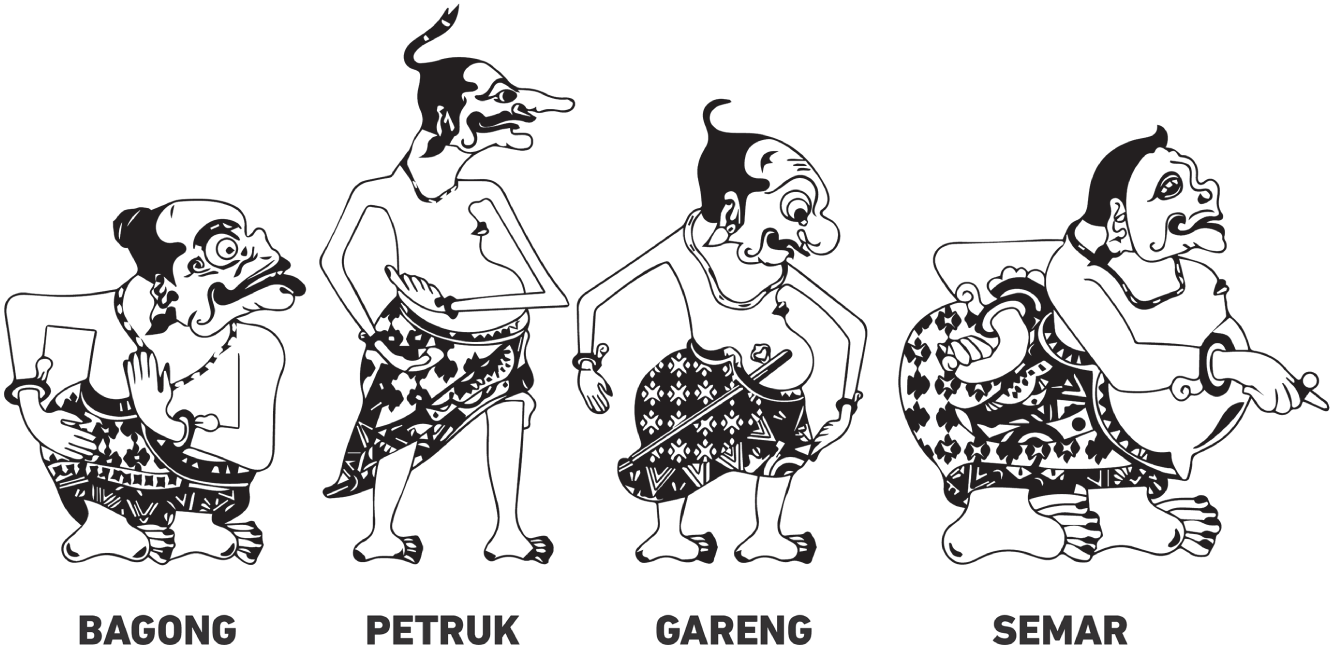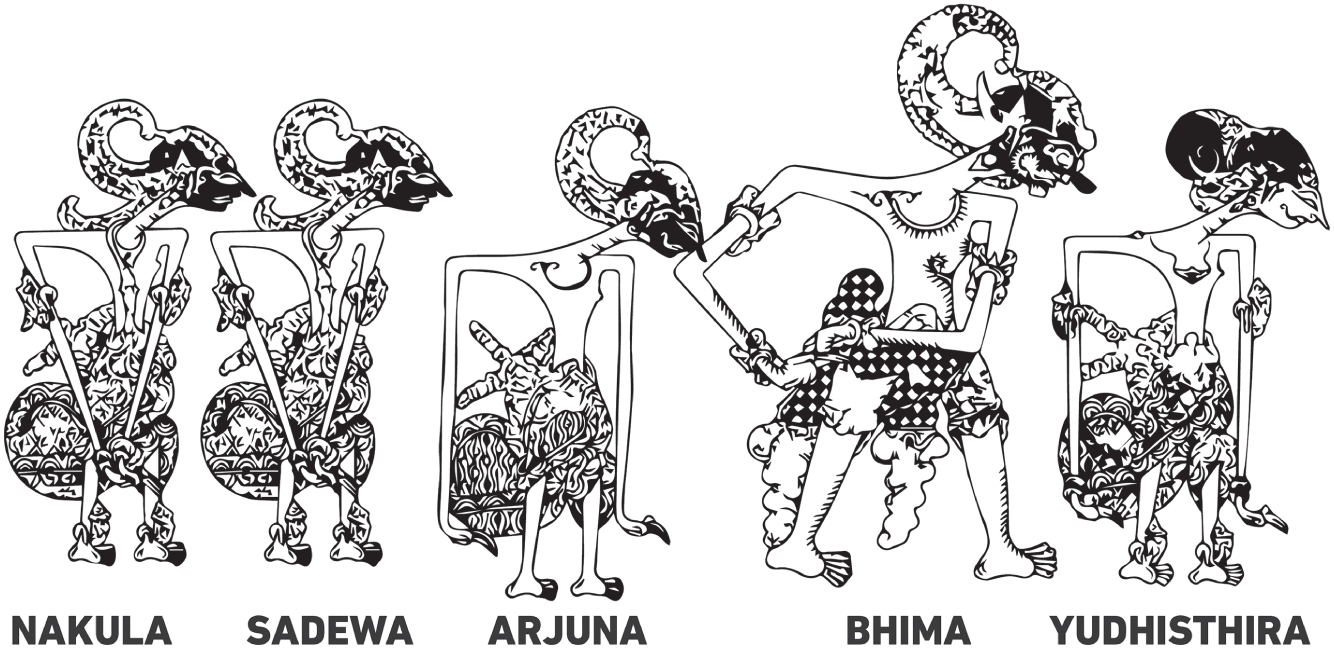Appendix: Punokawan and Pandava: The Indonesian Mythic Symbols of CI‐EL and PI‐PM in the Omnihouse Model
The concept of entrepreneurial marketing is intended to answer future challenges. The existence of digitalization and the COVID‐19 pandemic does require leaders to be agile, flexible, and resilient in dealing with change. CI‐EL is the answer so that business people, government officials, social activists, and leaders in various organizations do not stutter in responding to the dynamic environment.
The birth of this concept is also based on local Indonesian philosophy, especially from the wayang story, one of the cultural heritage stories in Indonesia. According to Javanese tradition, wayang stories are based on Indigenous mythologies and Indian epics.1 Wayang flourished in the royal courts of Java―Indonesia's main islands―and Bali for ten centuries. It has also spread to neighboring islands―Lombok, Madura, Sumatra, and Kalimantan―where it has evolved into various local performance styles and musical accompaniments.
The story that is popularly performed in the wayang shows is the Mahabharata. It is one of ancient India's two primary epics in addition to the Ramayana.2 The main protagonists in the story of the Mahabharata are the Pandava, five brothers called Yudhishthira, Bhima, Arjuna, Nakula, and Sadewa. They are nobles as well as knights with different supernatural powers.
In the Javanese tradition, there are also four local figures known as the Javanese version of clowns, called the Punokawan. They are the servants of the Pandava. The Punokawan comprise four characters: Semar, Gareng, Petruk, and Bagong. Even though they are described as funny characters, the Punokawan have great abilities and wisdom. They are often helpers and advisors to the Pandava.
This collaboration between the Punokawan and Pandava inspired the CI‐EL (creativity, innovation, entrepreneurship, and leadership) and PI‐PM (productivity, improvement, professionalism, and management) concepts as one of the primary dichotomies in the omnihouse model. Punokawan, with all their uniqueness and funny behavior―often providing unexpected solutions―are symbols of CI‐EL. Meanwhile, with their “elite” characters, the Pandava are the manifestation of PI‐PM.
Punokawan as the Symbol of CI‐EL
The youngest character of the Punokawan is Bagong. Bagong is short and chubby, but his eyes and mouth are wide.3 He is a funny character, likes to entertain, and is intelligent. Although his movements are not as agile as his other brothers, Bagong is known to have many ideas. That's why we chose it as an icon of creativity.
The second figure of the Punokawan is Petruk. This character has a large sense of humor but is also an agile fighter. Petruk has a distinctive face, a tall body posture, and a long nose. Other body parts―hands, neck, and legs―have similar characteristics. Petruk has many magical abilities and is willing to test his abilities in various situations.4 This character is similar to an innovator who likes experimenting with new ideas. So, Petruk is a symbol of innovation.
Gareng is the next Punokawan character. Unlike the other Punokawan, Gareng is described as a human figure with a body with some atypical features. He has crossed eyes, imperfect hands, and limp feet.5 But actually, Gareng's physical imperfection implies his unique ability. Crossed eyes are not a weakness; it symbolizes accuracy and thoroughness in seeing the surrounding environment. With this accuracy, Gareng can see opportunities that others have missed. This ability to see opportunities is one of the main characteristics of entrepreneurship.
Among the other Punokawan, Semar is the most senior figure. He is the father figure to other Punokawan. Semar's character is described as fat and having a short posture, an ample backside, and a snub nose.6 In Javanese wayang stories, he is the leader of other Punokawan and plays a central role as an advisor to the Pandava. Therefore, it is very appropriate that Semar represents leadership.

FIGURE A.1 The Punokawan
Pandava as the Symbol of PI‐PM
The youngest of the five Pandava brothers are the twins Nakula and Sadewa. Nakula has a deep understanding of horse‐keeping. He is also said to be a brilliant swordsman.7 Sadewa, the younger brother, is the most junior of the Pandava, but he has high intelligence, especially in astrology. He also has the same swordsmanship abilities as his brother.8 With their various skills and knowledge, the twins can provide multiple needs for their siblings. That is why they are suitable to represent productivity.
The next character is Arjuna. In the Mahabharata epic, he is the third among the Pandava. Arjuna was a great student in his boyhood, and his adored teacher, Drona, also favored him. As a grown‐up, Arjuna develops into a skilled archer.9 Arjuna always tries to improve his supernatural powers by meditating and practicing. Because of his persistence to keep improving, we chose Arjuna as a symbol of improvement.

FIGURE A.2 The Pandava
Bhima is a Pandava character with unique combat abilities. His tremendous stature and power set him apart from his brothers.10 Because of his physical ability, it is not uncommon for Bhima to get a mission to lead the battle. He can complete heavy tasks with excellence. Therefore Bhima is the correct figure to represent professionalism.
Yudhishthira is the older brother of the four other Pandava figures. Honesty, justice, tolerance, and discernment are all qualities he possesses. He is also known to be very strict with the rules.11 This characteristic sometimes causes him to be too rigid in directing the other Pandava. As the eldest of the Pandava, Yudhisthira is the most suitable figure to represent the management concept.
Notes
- 1 https://ich.unesco.org/en/RL/wayang-puppet-theatre-00063
- 2 Amaresh Datta, The Encyclopaedia of Indian Literature (Vol 2: Devraj to Jyoti). (New Delhi: Sahitya Akademi, 1988).
- 3 https://www.indonesia.travel/gb/en/trip-ideas/wayang-s-own-four-musketeers-punokawan
- 4 https://indonesiar.com/getting-to-know-the-punakawan-characters-petruk-in-javanese-puppetry/
- 5 https://soedonowonodjoio.family/the-story-of-our-ancestors/dive-into-the-philosophical-meaning-of-gareng,‐javanese‐puppet‐characters.html
- 6 Claire Holt, Art in Indonesia: Continuities and Change (Ithaca, NY: Cornell University Press, 1967).
- 7 Kanjiv Lochan, Medicines of Early India (with appendix on a rare ancient text) (Varanasi: Chaukhambha Sanskrit Bhawan, 2003).
- 8 https://dbpedia.org/describe/?uri=http%3A%2F%2Fdbpedia.org%2Fresource%2FSahadeva
- 9 https://www.britannica.com/topic/Arjuna
- 10 https://detechter.com/bhima-who-slayed-all-kauravas-including-duryodhana/
- 11 https://www.mahabharataonline.com/stories/mahabharata_character.php?id=59
